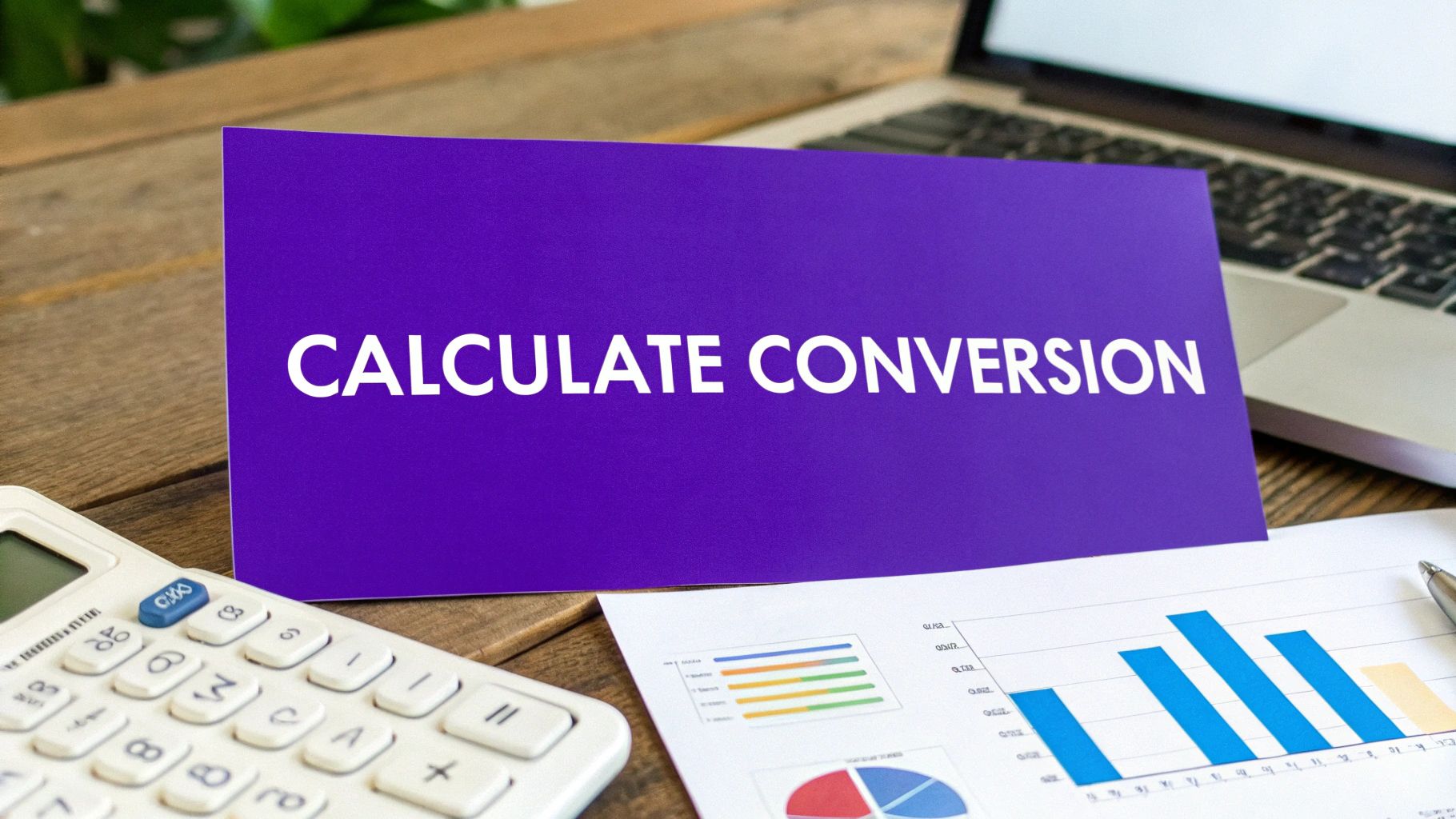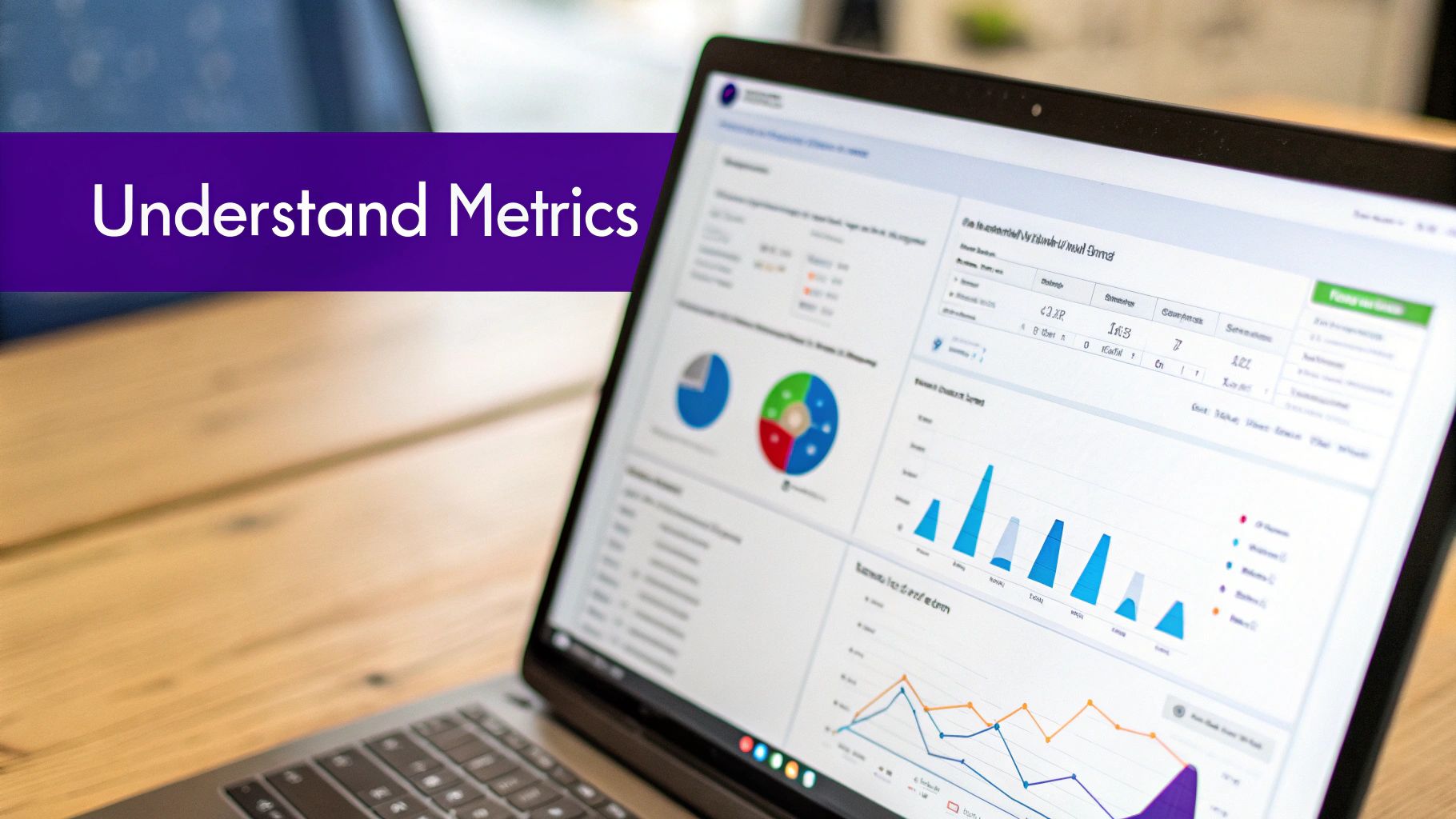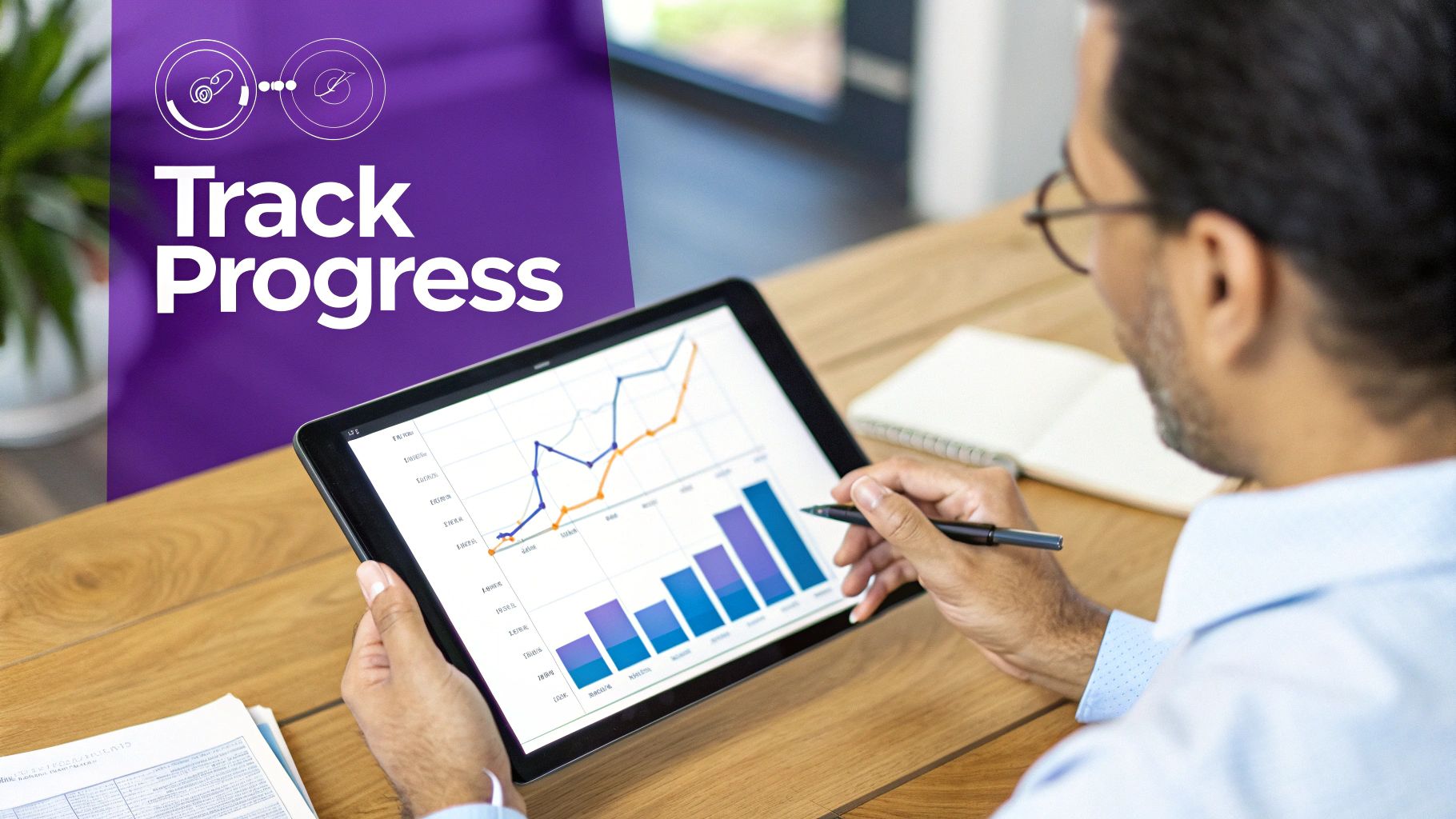How Do I Calculate Conversion Rate: The Ultimate Performance Measurement Guide

Demystifying Conversion Rate Calculations

Knowing how to measure your conversion rate is key to understanding if your online efforts are paying off. Let's break down exactly how to calculate this important metric and see how you can use it to improve your results.
The Basic Conversion Rate Formula
- Conversion Rate = (Conversions / Total Visitors) x 100
While this formula may look simple, it packs a punch. It shows you exactly what percentage of people who visit your site end up taking the action you want them to take - whether that's making a purchase, signing up for emails, or downloading content. For instance, if your site had 5,000 visitors in a month and 100 of them bought something, here's how you'd calculate it:
- (100 / 5,000) x 100 = 2%
That 2% means two out of every hundred visitors became customers. Even small improvements to this number can mean big gains for your business. Plus, tracking this metric helps you spot what's working and what needs fixing.
Applying the Formula: A Practical Example
Picture this: You run an online jewelry store that got 12,000 visitors this month, and 240 people bought your pieces. Here's how to figure out your conversion rate:
- Identify your conversions: You had 240 completed purchases
- Identify your total visitors: Your site saw 12,000 visitors
- Apply the formula: (240 / 12,000) x 100 = 2%
Your 2% conversion rate means that for every 100 people who visited your store, two made a purchase. Now you have a clear starting point to measure against as you test new marketing ideas and make website improvements.
Beyond the Basics: Different Conversion Types
While sales are often the main goal, you can calculate conversion rates for many valuable actions. The basic formula stays the same - you just need to be clear about what counts as a "conversion" for each goal. Here are some common examples:
- Lead Generation: When someone fills out your quote request form
- Newsletter Sign-Ups: When a visitor joins your email list
- Content Downloads: When someone downloads your ebook or white paper
By tracking conversion rates for different goals, you can see how well each part of your website and marketing plan performs. For example, monitoring newsletter sign-ups helps you understand if your content resonates with readers and grows your email list effectively.
Understanding these numbers lets you make smart changes to boost results across your business. Later, we'll explore what these percentages really mean and how to use them to drive real growth.
Real-World Conversion Benchmarks That Actually Matter
Understanding what your conversion rate means requires more than just calculating a percentage. To gain real insights, you need to compare your performance against relevant benchmarks that match your specific business context. This helps identify improvement opportunities while keeping expectations grounded in the realities of your industry and audience.
Why Industry Benchmarks Are Essential
Let's say you run an online bookstore with a 1.5% conversion rate. Without proper context, it's hard to know if that's good or not. While the average e-commerce conversion rate is 2.2%, comparing yourself only to that broad benchmark could be misleading. Other online bookstores might typically convert at 1.5%, making your performance quite solid within your specific niche. This illustrates why industry-specific benchmarks matter so much - they provide the right context for evaluation. For example, legal services websites often see rates around 3.8% since their services involve careful consideration and higher value. But this doesn't mean an e-commerce site should target that same rate, as the buying processes are completely different.
Understanding the Nuances Within Industries
Even businesses in the same industry can have very different conversion patterns based on what they sell and who they target. Take e-commerce - luxury retailers might see rates around 1.4% since purchases are less frequent and require more thought, while sites selling everyday items often convert better. Similarly, a business focused on a specific niche audience with particular needs may convert at a higher rate than one targeting the general public. This is why you need to find benchmarks that match your specific segment to set appropriate goals.
Establishing Your Own Performance Benchmarks
While industry standards provide useful reference points, you also need internal benchmarks based on your unique situation and goals. For instance, if you currently convert at 1% and want to reach 1.5% next quarter, that 0.5% increase becomes your key performance target. By tracking against your own benchmarks, you can better measure if your optimization efforts are working and spot areas needing attention.
| Industry | Average Conversion Rate |
|---|---|
| E-commerce | 2.2% |
| Legal Services | 3.8% |
| Healthcare | 3.1% |
| Luxury Goods | 1.4% |
By looking at both industry standards and your own historical data, you get a complete picture of how well your website performs and can make smarter decisions about improvements. With this foundation in place, let's explore some advanced calculation approaches for different business models.
Advanced Calculation Strategies for Different Business Models

Every business tracks conversions differently based on their unique customer journey. While the basic concept remains the same, the specific metrics and calculations need to match how your business operates and what defines success for your model. Let's explore how different types of companies approach conversion tracking to get meaningful insights.
B2B Lead Generation: Measuring the Value of Connections
For B2B companies, conversions often focus on qualified leads rather than immediate sales. This could be someone downloading a whitepaper, requesting a product demo, or starting a free trial. For example, if a B2B software company gets 1000 website visitors and 50 request a demo, that's a 5% conversion rate for demo requests. Beyond just tracking these numbers, B2B companies need to monitor how leads move through each stage of their sales pipeline to understand where potential clients might drop off.
E-Commerce Sales: Focusing on the Final Purchase
E-commerce businesses primarily track completed purchases as their main conversion metric. The expected rates can vary significantly by product type - a $2000 couch naturally converts at a lower rate than a $20 phone case since bigger purchases need more consideration time. Smart e-commerce companies also look at related metrics like average order value and how well complementary product recommendations perform to get the full revenue picture.
Subscription Services: Prioritizing Customer Lifetime Value
With subscription businesses, getting someone to sign up is just the start. The real measure of success is keeping customers subscribed over time. This means closely watching metrics like: How many trial users become paying customers? What percentage cancel each month? How long do subscribers typically stay? A streaming service might get lots of free trial signups, but if most cancel before paying, those initial conversion numbers don't tell the whole story. Success requires optimizing the entire customer lifecycle.
Multi-Touch Attribution: Unraveling Complex Conversion Paths
Most purchases today involve multiple interactions across different channels. Someone might see a social media ad, visit your website a few times, read reviews, and finally make a purchase weeks later. Multi-touch attribution helps understand how each of these touchpoints contributes to the final conversion. While more complex to track, this approach shows which marketing channels work together most effectively to drive sales. This insight helps companies spend their marketing budgets more wisely by focusing on the combination of touchpoints that consistently lead to conversions.
Mastering Multi-Channel Conversion Tracking
Most customers take a winding path before making a purchase. They might first discover your product while scrolling Instagram, visit your website to learn more, check reviews on other sites, and finally buy after clicking a Google search ad weeks later. This complex journey makes tracking conversions much more nuanced than simply counting sales. Understanding how each interaction influences the final purchase is key to getting the most from your marketing efforts.
The Challenge of Multi-Touch Attribution
Looking at just one touchpoint for conversion tracking paints an incomplete picture. Consider a common scenario: someone discovers your site through social media, later returns via an email campaign, and eventually makes a purchase. If you only credit the email click, you miss how social media sparked their initial interest. This is where tracking multiple touchpoints becomes essential.
Exploring Different Attribution Models
There are several ways to give credit to the touchpoints that lead to a conversion:
- Last Click: Assigns all credit to the final interaction before purchase. While straightforward, this overlooks earlier touchpoints that built interest.
- First Click: Credits the initial touchpoint where someone discovered your brand. Good for measuring awareness, but doesn't show how later interactions drove the sale.
- Linear: Splits credit evenly across all touchpoints. Provides balance but may not reflect that some interactions had more impact.
- Time Decay: Gives more weight to recent touchpoints, recognizing that interactions closer to purchase often matter more.
- Position-Based: Emphasizes first and last touchpoints since brand discovery and final decision-making are critical steps.
Pick the model that fits your business - for example, companies with longer sales cycles often benefit from time decay attribution.
Implementing Multi-Channel Tracking in Practice
Getting multi-channel tracking right requires both the right tools and proper setup:
- Unified Analytics Platforms: Google Analytics 4 helps track behavior across channels, from website visits to app usage and social engagement. This gives you a complete view of the customer journey.
- Consistent Tracking Parameters: Add UTM parameters to your URLs to identify traffic sources, marketing channels, and specific campaigns. This helps measure how different channels drive conversions.
- Custom Event Tracking: Set up tracking for key actions beyond pageviews - newsletter signups, video plays, demo requests, etc. This provides deeper insight into how people engage with your content.
Turning Data into Actionable Insights
Gathering data across channels is just the start - the real value comes from using those insights to improve your marketing. For instance, if you see social media driving awareness but few direct sales, you might focus social posts on moving traffic to targeted landing pages or building an email list. By understanding how channels work together, you can better allocate your budget and resources. The goal isn't just calculating conversion rates, but steadily improving them across every marketing channel.
Avoiding Critical Conversion Calculation Mistakes

Getting your conversion rate calculations right is essential for making smart business decisions. While the basic formula may seem simple, several common mistakes can throw off your numbers and lead you down the wrong path. Let's explore these pitfalls and learn how to avoid them so you can confidently answer "How do I calculate conversion rate?" and put that data to good use.
Identifying and Correctly Defining "Conversions"
The first step is being crystal clear about what counts as a conversion on your website. This goes beyond just tracking sales - it includes newsletter signups, content downloads, demo requests, and free trial starts. For example, if you're focused on lead generation, make sure you're only counting qualified leads rather than every form submission. Being specific about what actions matter most helps you set meaningful goals and measure real progress.
Accounting for All Relevant Traffic Sources
Don't fall into the trap of only looking at certain traffic sources when calculating conversion rates. While it makes sense to analyze specific campaigns, you need the full picture - including organic search visitors, social media referrals, and other channels. For instance, if social media drives a lot of traffic to your site, those visitors need to be included in your total count to get accurate conversion rates. Looking at all sources gives you a true understanding of how well your site converts visitors overall.
Ensuring Consistent Tracking Across Platforms
With visitors coming from many different places, keeping your tracking consistent is key. Using different analytics tools or tracking methods across channels can create data discrepancies that skew your conversion numbers. Make sure your Google Analytics setup matches your CRM data and other platforms. Pay special attention to how you track conversions in Google Analytics 4, which lets you measure both session and user conversion rates. User rates show how many people converted across multiple sessions, while session rates tell you the percentage of visits that included a conversion.
Regularly Auditing and Validating Your Data
Technical issues, tracking code problems, and website changes can all impact your data quality over time. That's why it's important to regularly check your conversion tracking setup and compare the numbers against other business metrics. This is especially crucial if you have a complex sales funnel or multiple conversion points. For example, cross-reference your conversion data with actual sales figures and lead reports to spot potential tracking issues. Regular A/B testing can also reveal conversion problems beyond calculation errors.
The Impact of Inaccurate Conversion Rates
Small mistakes in conversion calculations can seriously impact your business decisions. When your numbers are off, you might spend your marketing budget in the wrong places or make changes that hurt rather than help conversions. By understanding these common pitfalls and following best practices, you can trust your conversion rate data to guide smart choices for growing your business. Taking a careful, thorough approach helps you both calculate and optimize conversion rates effectively.
Converting Simple Math into Real Growth

Understanding your conversion rate is more than just doing math - it's about making smart business choices. When you track this key number regularly, you can spot what's working, improve your customer experience, and help your business grow. Let's look at how real companies use conversion tracking to get better results.
Making the Most of Your Sales Funnel
Once you know how to measure conversions, the next step is using that information to improve your sales process. This means looking closely at each step customers take - from first finding your business to making a purchase - and finding where people drop off. For example, if lots of people add items to their cart but don't complete their purchase, there might be issues with your checkout process. Maybe it's too complicated or shipping costs surprise customers. Companies like Dollar Shave Club show how this works - they made signing up super simple, which helped more people become customers.
Testing What Works Best
After finding areas to improve, it's time to test different approaches. A/B testing lets you try different versions of your web pages, ads, or marketing campaigns. By tracking conversion rates for each version, you can see what your audience prefers and what leads to more sales. For instance, Airbnb constantly tests and improves their website based on real data about what works. This ongoing process helps keep their marketing and website performing well.
Real Results: How Airbnb Uses Data
Airbnb offers a great example of using conversion data effectively. Their team analyzed how people used their site and tested different approaches. One key finding? High-quality photos of rentals led to many more bookings. This simple change, discovered through careful testing, made a big difference in their business growth. It shows how paying attention to conversion rates can point to practical changes that boost revenue.
Building a Process That Works
To grow your business using conversion rate data, you need a clear plan. Here's what that typically includes:
- Clear Goals: Set specific targets for your conversion rates that make sense for your business
- Key Numbers: Watch important metrics throughout your sales process
- Customer Behavior: Learn how people actually use your website or app
- Testing Changes: Try new approaches based on what you learn
- Measuring Results: See how your changes affect conversion rates
- Ongoing Improvements: Keep checking your data and adjusting your approach
This step-by-step process helps you consistently improve based on real results. When you focus on measuring conversions and using that information wisely, simple calculations become a powerful tool for growing your business.
Ready to improve your online store and increase sales? Wand Websites provides expert design and development services for e-commerce businesses. We help create websites that attract visitors, boost sales, and keep customers coming back. Visit us today to learn how we can help your business grow.


